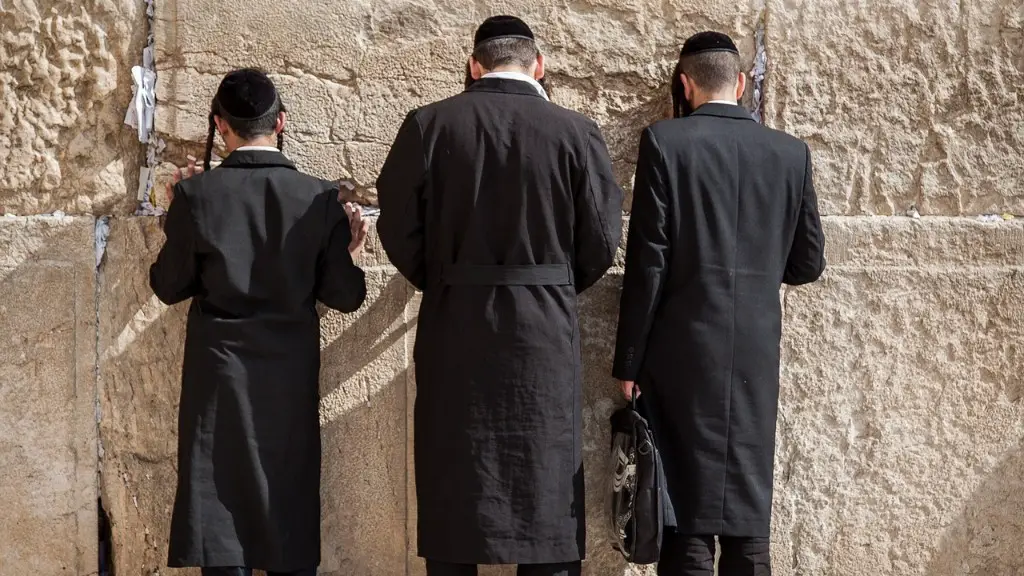Orthodox and Hasidic Judaism are both branches of the same Abrahamic faith that stem from ancient Rabbinical traditions. There are distinctions between the two types of Judaism, yet each also has a number of similarities. Knowing the differences between Orthodox and Hasidic Judaism is essential for understanding the many different branches of modern-day Judaism and appreciating the unique beliefs and practices that each of them consists of.
The most basic difference between Orthodox Judaism and Hasidic Judaism is that Orthodox Jews adhere to the Oral Torah and written scriptures of the Torah, and Hasidim observe the same texts and teachings in a much more strict and literal sense. The Hasidim or “pious ones” are a sect of ultra-Orthodox Jews who are considered the most conservative and religious among all of Judaism. Hasidim follow certain sectarian rules, beliefs and lifestyle practices, such as wearing traditional clothing and adhering to stricter versions of Kosher laws. These stricter practices are based on the understanding that a relationship between God and man is possible, and that Hasidim strive to increase their closeness to God through their way of life.
Although Orthodox Jews also believe that an individual has a direct relationship to God and can draw closer to Him through right action, their beliefs and practices emphasize a focus on the observance of the 613 mitzvot, or commandments, of the Torah as outlined in the Oral Law. While Hasidic Jews follow a strict way of life, Orthodox Jews are guided by the tenets—but not necessarily the principles—of the ancient rabbinical sages, regarding matters related to marriage, personal status and family matters such as Shabbat and Jewish holidays.
The stances of Orthodox and Hasidic Jews on modern-day matters and issues also vary. Orthodox Jews typically attempt to accommodate the needs of modern society within their principles, while Hasidim attempt to remain completely Orthodox and as separate from all other societies as possible, leading a life that is as insulated and pure as possible. Orthodox Jews see modernity as an opportunity to build bridges and learn, while traditional Hasidic Jews are wary of the outside world and view it with suspicion.
The difference between Orthodox and Hasidic Jews is also manifested in the spirituality within their communities. Hasidism is founded on a specific line of mystical thought and teachings known as Chassidus, while Orthodox Jews mostly emphasize the more outwardly focused aspects of traditional Judaism such as numerous mitzvot that are specific to the everyday life of a Jew, along with daily prayers and occasionally even embracing meditative practices and kabbalistic insights.
It is also important to note that although there are distinct differences between Orthodox and Hasidic Jews, their shared roots in Abrahamic faith and Scriptural interpretation lead to different paths but foster the same spirit: an effort to draw closer to God and to do His will. From a scholarly perspective, those differences can inform our understanding of the diversity of beliefs and practices that come along with the study of Judaism and form a necessary part of a richer, more meaningful spiritual life.
Led by Rabbis in Different Ways
One of the major distinctions between Orthodox and Hasidic Judaism is the way each is led by its Rabbis. The teachings of Orthodox Jewish Rabbis have an impact upon the way that their followers live and practice the religion. As with other branches of Judaism, Orthodox Judaism allows for some flexibility in interpretation of the scriptures and in the application of the teachings – however, Rabbis who promote far-reaching change are rare. The primary role of the Orthodox Rabbi is to elaborate on and explain traditional interpretations of the Scriptures, citing oral and written texts as the basis for their teachings.
On the other hand, Hasidic communities are largely centralized around the teachings of a single ‘Rebbe’, a title given to the spiritual leader of a Hasidic sect. Rebbes generally hold great weight in modern Hasidic communities and serve as both a Rabbinical figurehead and a figure of spiritual inspiration. An emergence of a popular ‘Rebbe’ has been known to bring about changes in the whole community’s religious behaviour, values, and practices, sometimes taking the form of a “personified” Hasidic way of life that the Rebbes promulgate.
This adherence to the spiritual authority of the Rebbes is an important part of the difference between Orthodox and Hasidic mindset, and its presence serves as an evidence of the powerful influence that one leader can have. The presence of this ‘higher being’ is also a major factor that encourages the Hasidim to strive for a higher spiritual attainment than may be possible through traditional Orthodox study.
Evolution of Halachic Tradition
An Orthodox religious leader or halachic authority is generally bound by established jurisprudence and legal precedent in providing their interpretation of Jewish law. This is not necessarily the case for the adherents of the Hasidic faith. As Jews of Hasidic sects generally rely more heavily upon their spiritual mentors and Rebbes, they may be more likely to entertain a new idea or legal opinion that previously had not been accepted by a greater population of Jews.
In contrast, Orthodox Jewish Rabbis are much more likely to refer to traditional halachic sources when providing interpretations or opinions on Jewish law. Orthodox Rabbis take a much more cautious and nuanced approach to interpreting the laws, as their opinions can affect the way that hundreds or even thousands of adherents live their lives. This is not to say that Orthodox Rabbis do not entertain innovative interpretations of the laws, but in most cases, if the opinion of an Orthodox Rabbi is to become accepted by a greater population, its accuracy must be established and proven through traditional Jewish jurisprudence.
This difference in the tradition of halachic authority serves as yet another important distinction between Orthodox and Hasidic beliefs and practices. This classical religious difference has truly come to the fore in recent years, with both branches continuing to produce their own new interpretations of the text and evolve their traditional interpretations of the Rabbinical teachings.
Different Implications for Intelligence and Growth
Due to their adherence to a much stricter form of Judaism, adherents of Hasidism are typically exposed to a different style of learning and education than those of other branches of Judaism. Traditional Hasidic education typically encompasses a wide range of topics and subjects, but it largely focuses on teachings derived from the Chassidic and Kabbalistic texts. This style of learning encourages followers to develop a deep understanding and appreciation of the religious material studied, as well as a special connection between the Torah and the divine.
In contrast, the style of Jewish education provided by Orthodox Jewish institutions generally relies more heavily on the study of statutory Jewish law and textual interpretation. The emphasis that is placed on engaging with the texts and acquiring knowledge in a structured and systematic manner can serve to further expand students’ knowledge and knowledge of the larger nexus of Jewish law and tradition.
Because Orthodox and Hasidic Judaism both provide distinct styles of religious education, adherents of both branches tend to value certain aspects of Jewish life more than others. Due to the broader scope of learning, those exposed to a Hasidic education tend to place a higher value on the ‘inner’ aspects of the religion, while those exposed to an Orthodox education tend to focus more heavily on the ‘outer’ aspects of Jewish law and practice, such as ritual observance and community service.
Differences in Prayer Services
The differences between Orthodox and Hasidic Judaism are also reflected in their respective rituals and prayer services. Generally, the language and style of prayer differ slightly between the two branches of Judaism. The most noticeable differences tend to be in the length of some of the services. Hasidic prayer services are often longer and more intense than those of the Orthodox. These services usually include more singing, dancing and heartfelt devotionals.
The liturgy of these services also differs between the two branches of Judaism. While both branches of Judaism use Hebrew when they pray, the Hasidic prayer services are not only chanted, but also sung, with some Hasidim joining in with the music. Orthodox prayer services commonly include the full Hebrew text of the prayer and are not usually sung. Most also include additional hymns and readings. This is not a universal practice, however, and some Orthodox Jewish congregations and individuals will occasionally also incorporate music into their prayer services.
Differences in Clothing and Appearances
The physical differences between Orthodox and Hasidic Jews are also quite noticeable. Orthodox Jews often choose to wear modern clothes, and do not necessarily differentiate male and female attire in the way that traditional Orthodox communities do. Hasidic Jews, on the other hand, are known for their traditional black clothing, or “shtreimel” hats, which indicate that they are members of a distinct sect of Hasidism. These traditional garments also serve to signify that Hasidim maintain a strict separation from the outside world and do not engage in secular activities such as television, movies, or modern technology.
The physical distinctions between Hasidic and Orthodox Jews often carry over into their respective synagogue settings as well. In many Orthodox Jewish congregations, the genders will be separated during prayer, a practice known as mechitza, and women may be asked to wear a head covering. In Hasidic communities, the level of segregation between men and women goes much further, with women often relegated to a separate area of the synagogue to pray, learn and study separately from the men.
Conclusion
Ultimately, the differences between Orthodox and Hasidic Jews run quite deep and cannot necessarily be confined to physical appearances, prayer services, or education. As these distinctions are often based upon shared roots in Rabbinical tradition, appreciating their spiritual implications can help illuminate the diversity and richness of Jewish practice today. In understanding these distinctions, one can come away with a more nuanced appreciation of Jewish life, and a better understanding of how both branches ultimately strive towards the same spiritual ideal.




